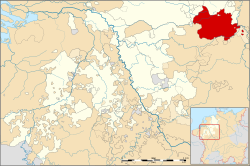Prince Bishopric of Paderborn
| Prince-Bishopric of Paderborn | ||||||||||
| Fürstbistum Paderborn | ||||||||||
| State of the Holy Roman Empire | ||||||||||
|
||||||||||
|
||||||||||
|
Map of the Lower Rhenish–Westphalian Circle around 1560,
Prince-Bishopric of Paderborn highlighted in red |
||||||||||
| Capital | Paderborn | |||||||||
| Languages | West Low German | |||||||||
| Government | Elective principality | |||||||||
| Historical era | Middle Ages | |||||||||
| • | Bishopric established | 799 | ||||||||
| • | Bishopric gained bailiwick over itself |
ca 1200 |
||||||||
| • | Gained Reichsfreiheit | 1281 | ||||||||
| • | Secularised to Prussia | 1802 | ||||||||
| • | Ceded to Kgdm Westphalia | 1807–13 | ||||||||
|
||||||||||
| Neighbouring states reduced to abbreviations in the map are as follows: AC indicates Corvey Abbey; FL is Lippe; GW is Waldeck; HD is Hesse-Darmstadt; HK is Hesse-Kassel; SY is Sayn. More general abbreviations include Bm for Bishopric (German: Bistum); Gft for County (Grafschaft); Hzm for Duchy (Herzogtum) and Landgft for Landgraviate (Landgrafschaft). |
||||||||||
The Prince-Bishopric of Paderborn (German: Fürstbistum Paderborn) was a principality (Hochstift) of the Holy Roman Empire from 1281 to 1802.
The Diocese of Paderborn was founded in 799 by Pope Leo III. In the early years it was subordinated to the bishop of Würzburg. Since 855 the clergy had the right to elect the bishop. The diocese included the larger part of Lippe, Waldeck, and nearly half of the County of Ravensberg.
In 1180 when the Duchy of Saxony ceased to exist, the rights which the old dukedom had exercised over Paderborn were transferred to the Archbishopric-Electorate of Cologne. The claims of the archbishops of Cologne were settled in the 13th century, almost wholly in favor of Paderborn. Under Bernhard II of Ibbenbüren (1198–1204) the bailiwick over the diocese, which since the middle of the 11th century had been held as a fief by the Counts of Arnsberg, returned to the bishops. This was an important advance in the development of the bishops' position as a secular ruler in his temporalities, forming a Hochstift of imperial immediacy since. From this time on the bishops did not grant the bailiwick as a fief, but managed it themselves, and had themselves represented in the government by one of their clergy. They strove successfully to obtain the bailiwicks over the abbeys and monasteries situated in their diocese.
Bishop Otto von Rietberg had to contend with Cologne; in 1281, when only bishop-elect, he received the regalia from Rudolph of Habsburg, and full judicial power (except penal judicature). After the defeat of the Cologne arch bishop at the Battle of Worringen 1288 the bishops of Paderborn became increasingly sovereigns, though not over the whole of their diocese. Bernhard V of Lippe (1321–41) established a first territorial constitution ("Privilegium Bernhardi"). However he had to acknowledge the city of Paderborn as free from his judicial supremacy. Heinrich III Spiegel zum Desenberg (1361–80), also Abbot of Corvey, left his spiritual functions to a suffragan; in 1371 he rebuilt the Burg Neuhaus at Paderborn. Simon II, Count of Sternberg (1380–89), involved the bishopric in feuds with the nobility, who after his death devastated the country. Wilhelm Heinrich van Berg, elected 1399, sought to remedy the evils which had crept in during the foregoing feuds, but when in 1414 he interested himself in the vacancy in the Archbishopric of Cologne, the cathedral chapter in his absence chose Dietrich III of Moers (1415–63). The wars of Dietrich, also Archbishop of Cologne, brought heavy debts upon the bishopric; during the feuds of the bishop with the city of Soest (1444–49) Paderborn was devastated.
...
Wikipedia



